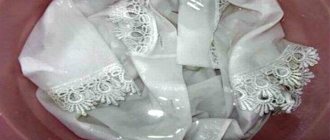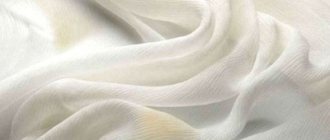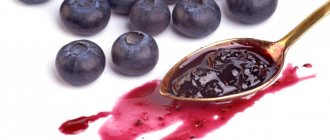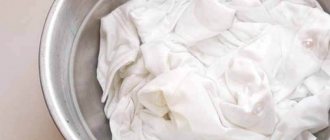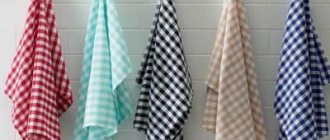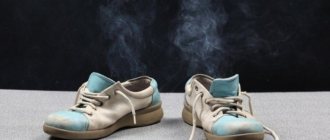Any housewife wants to achieve impeccable whiteness of clothes at home. The ability to keep tablecloths, school shirts, children's linen and kitchen towels perfectly clean is a rarity. Bleaching white clothes with hydrogen peroxide is a simple and effective way to achieve cleanliness, proven over the years.
Bleaching with hydrogen peroxide is an ancient way to achieve cleanliness.
Advantages and disadvantages of bleaching laundry with hydrogen peroxide
Benefits of bleaching white fabrics with hydrogen peroxide:
- low cost;
- removal of old plaque and yellowness;
- ease of use;
- preservation of the structure of the material;
- application for delicate fabrics;
- returning washed laundry to its original appearance;
- removing stains from deodorant, sweat and oil;
- availability of the drug.
The only downside to bleaching with hydrogen peroxide is the smell. Replace 1 tbsp. l. 3% peroxide can be 1 tablet of hydroperite. The effects of the drugs are the same.
Attention! The whitening effect is achieved by directly applying the product to the stain. The matter is saturated with oxygen, which breaks down the dirt.
Peroxide is a readily available antiseptic. The drug is sold in any pharmacy in the country. For bleaching, use a 3% peroxide solution. Usual composition concentration: 2 tbsp. l. drug per 10 liters of hot water.
We recommend reading: How to remove brilliant green from linoleum
Citric acid and lemon juice
These products perfectly remove gray and yellow plaque, but are harsh, so they are only suitable for cotton fabrics. Also, using citric acid, remove stains on shoes: sneakers, textile ballet shoes.
- Dissolve 10 tablespoons of citric acid or juice from two citrus fruits in a 10-liter bucket of hot water.
- Soak white items for 5-6 hours.
- Rinse and leave to dry.
We recommend: Is it possible to wash oilcloth in a washing machine: options for different materials
Features of bleaching laundry with hydrogen peroxide
White clothes look noble. But maintaining her ideal appearance for as long as possible is quite difficult. Light-colored linen quickly washes out, acquires a yellow tint and loses its shine. The use of hydrogen peroxide to remove stains from fabrics is associated with some features:
- When restoring the material, do not mix dark and light underwear to avoid shedding.
- Old yellow stains from wool and silk are removed in several stages. Clothing is placed in a mixture of peroxide diluted with water. After 30 minutes, the product is drained, the laundry is washed and dried. If dirt remains, the procedure is carried out the required number of times until the color is restored.
- Removing yellow stains from cotton and linen is carried out by directly applying a peroxide solution to the material. If the yellowness remains, the procedure is repeated until the contamination disappears.
- Bleaching is carried out only once every 3-4 washes, otherwise the strength properties of the material will be lost.
- After bleaching, clothes are rinsed in 2 stages: first at a temperature of 20-40 ° C, and then in cold water.
Each type of matter has its own recipe for restoring whiteness. Therefore, when bleaching, things are separated not only by color, but also by type of fabric: synthetics, silk and wool, or cotton and linen.
Oxygen-containing bleaches
The main advantage of such products is delicate whitening. With their help, grayness is removed even from silk blouses and dresses. Oxygen-containing bleaches disinfect fabrics and remove unpleasant odors.
The substances are easy to rinse out, so people do not experience allergic skin irritations later. Suitable for whitening children's clothes.
But oxygen-containing bleaches also have two disadvantages: high consumption and high cost.
How to bleach clothes with hydrogen peroxide
With repeated washings, the white item turns gray and dull. To restore the color saturation of the laundry, prepare a composition at the rate of ¼ cup of hydrogen peroxide per 5 liters of water at a temperature of up to 40 ° C. The laundry is left in the resulting mixture for 3 hours, then rinsed with the addition of vinegar or balm for delicate natural fabrics.
It is recommended to use a 3% peroxide solution when bleaching fabrics in the following ways:
- to get rid of old yellow stains, white clothes are soaked in the mixture for 1-2 hours;
- to avoid gray deposits on bedding, add 1/2 cup of hydrogen peroxide to the automatic machine when washing clothes;
- to restore the original color, white items are soaked in the solution for 1-3 hours;
- To whiten clothes from tea, coffee, wine, fruit, juice and blood, the composition is applied directly to the stain.
We recommend reading: The benefits of white wine and how to make it at home
How to bleach wool laundry with hydrogen peroxide
Stains on white clothes made from fabrics containing wool or silk are removed by hand washing. A solution to remove stains with hydrogen peroxide prepared from the following ingredients:
- 200 g table salt;
- 25 g of detergent for delicate fabrics;
- 10 liters of water at a temperature of up to 30 °C;
- 700 ml 3% peroxide.
Delicate items made of wool and silk are washed by hand at a temperature of 25-35 oC
Place white clothes in the prepared mixture for 3-5 hours. Then carefully remove the item using pressing movements. The product is not pulled out, but everything is taken out at once, pressing with both hands. Draw warm water up to 35 ° C and rinse the laundry well with conditioner for delicate fabrics. The washed clothes are carefully laid out on a horizontal surface covered with a terry towel.
Washing a down scarf:
To restore the whiteness of down products, add 2 tbsp to 10 liters of water at a temperature of 30-35 °C. l. peroxide and place a shawl or scarf in the resulting mixture for 20 minutes. After washing, the product is rinsed with the addition of vinegar and hair conditioner.
How to bleach synthetic items using hydrogen peroxide
White underwear made of thin synthetic material wears out and loses color over time. Bleaching bras and panties with hydrogen peroxide. To do this, soak underwear in the following composition:
- 10 liters of water at a temperature of 20-30 ° C are taken into the basin;
- diluted with 3 tbsp. 3% hydrogen peroxide stirring;
- soak white underwear in the prepared product for 1 hour;
- The laundry is placed in an automatic machine, washed in the usual way, rinsed with the additional rinse function and dried.
Advice! To bleach polyester lace underwear, use only granular powder or a product for delicate white fabrics.
Soaking white synthetic items in a prepared peroxide solution for 30 minutes before the main wash will remove the smell of sweat from your laundry.
How to bleach white linen and cotton items with hydrogen peroxide
White linen and cotton items are bleached with a 3% peroxide solution, placing it directly into the powder compartment of the automatic machine during washing. 15 ml of peroxide is added to the cell at a water temperature of 65 °C.
To bleach a T-shirt and knitwear, hydrogen peroxide is poured into a plastic basin or bucket with 2 liters of water at a temperature of 40-65 ° C and 1 tsp is added. peroxide. White T-shirts are placed in the resulting composition for 20 minutes. After this, the clothes are rinsed and dried.
If white knitted clothing has yellow spots, add 1 tsp to the resulting product. soda This will give the product a lost whiteness.
How to whiten white socks with hydrogen peroxide:
Use of mustard powder
Mustard is the best home remedy for removing grease stains from white clothes. Housewives use mustard powder to care for cotton tablecloths, towels, and kitchen curtains.
The procedure is as follows:
- Dissolve a bag of mustard powder in 5 liters of hot water.
- Leave things in the solution for 3 hours.
- Rinse with clean water to remove any traces of mustard and place in the washing machine.
- Dry white items.
How to enhance the effect of fabric bleaching with hydrogen peroxide
A hydrogen peroxide solution removes stains on cuffs and collars and restores the appearance of gray, worn clothes. The following drugs help enhance the bleaching effect of white fabrics:
- ammonia;
- soda ash;
- lemon juice or acid;
- laundry soap.
This composition is used only for washing white items. It is impossible to remove stains on colored fabrics with this product, since the combination of peroxide with other substances can lead to discoloration of the material.
Peroxide and ammonia for whitening
Ammonia will help get rid of gray plaque and yellowness on white fabrics and enhance the whitening effect. For this we recommend:
- Dilute 1 tbsp in 5 liters of water at a temperature of up to 40 °C. l. peroxide and 1 tbsp. l. ammonia.
- Dip white clothes into the resulting solution and leave to soak for 30-50 minutes.
- After the time has passed, snow-white items are rinsed twice and washed daily.
Whitening tulle with hydrogen peroxide is carried out with a composition of:
- 10 liters of water, temperature 40-65 oC;
- 2 tbsp. l. 3% peroxide;
- 1 tbsp. l. ammonia.
The tulle is placed in the resulting mixture, soaked for 5-10 minutes, and rinsed thoroughly with warm and cold water.
A solution of hydrogen peroxide and ammonia with water helps restore lost whiteness to things
To bleach a blouse or shirt, dilute 1 tbsp in 10 liters of water at a temperature of 40-70 °C. l. ammonia and 2 tbsp. l. 3% hydrogen peroxide solution. The laundry is dipped into the resulting composition for 20-30 minutes and rinsed thoroughly.
To ensure that cuffs and collars are washed perfectly, they are first rubbed with laundry soap. This enhances the whitening effect.
Hydrogen peroxide and baking soda for whitening clothes
A mixture of hydrogen peroxide and soda has an effect comparable in quality to professional bleach. To restore the whiteness of collars and cuffs, prepare a paste of 10 ml of peroxide and 1 tsp. soda The resulting composition is applied to the contaminated areas with a brush and left for 5-15 minutes. Then wash in an automatic machine with an additional rinse function.
We recommend reading: Baking soda: beneficial properties, uses, how to take
A paste made from hydrogen peroxide and baking soda whitens shirt cuffs and collars.
When bleaching children's whites and kitchen towels with a mixture of hydrogen peroxide and soda, excellent results are obtained. This mixture has proven itself well among housewives. Add 1 tsp to 2 liters of water at a temperature of 30 °C. peroxide and 1 tbsp. l. soda ash. White items are placed in the mixture for 10 minutes and washed as usual.
Cotton and linen white kitchen towels can be bleached using soda ash and peroxide, which are poured into the laundry detergent compartment. At a temperature of 60-70 oC, laundry is washed as usual. It is not recommended to use additional stain removers with this method.
Attention! Use baking soda and peroxide bleach only on cotton and linen fabrics. Before using the paste on things, the product is tested in an inconspicuous place of the product so as not to burn the material.
School white shirts cause a lot of trouble for housewives. Stubborn stains from sweat and deodorants, greasy food marks, marks from a ballpoint pen - all this must be removed from the child’s clothes. The following solution will help to bleach a blouse with hydrogen peroxide from sweat and yellow stains:
- 4 liters of water at a temperature of 40-70 ° C;
- 2 tbsp. l. soda ash;
- 2 tsp. peroxide.
A shirt or blouse is dipped into the resulting composition for 15 minutes. After the time has passed, the items are thoroughly rinsed and dried.
Stages of whitening a blouse using a solution of water, hydrogen peroxide and soda
Whitening with hydrogen peroxide and citric acid
A solution of lemon juice or acid and hydrogen peroxide can even cope with stains from fuel oil and diesel fuel on white things. To prepare the composition you will need:
- 2 liters of warm water;
- 1 tsp. peroxide;
- 1 tsp. citric acid.
White clothes with stains are soaked in the resulting mixture for 10-15 minutes, rinsed well and washed.
Synthetic fibers react well to citric acid, which helps to delicately deal with stains on white items. For this:
- Water at a temperature of up to 40 °C is filled into the basin.
- Add 1 tsp. hydrogen peroxide.
- Squeeze juice from ½ part lemon.
- Mix the composition thoroughly.
- Place clothes made of synthetic fabric for 20-30 minutes.
- Rinse things thoroughly, first at temperatures up to 40 ° C, and then in cold water.
The composition of citric acid and hydrogen peroxide gently whitens synthetic fabrics
The resulting solution eliminates yellowness on white blouses. To do this, apply the mixture to the areas of contamination with a sponge and leave for 30 minutes. If necessary, wash the entire item with this mixture.
Light jeans always have a problem bleaching. A composition of citric acid and hydrogen peroxide will cope with stains on things. To do this, mix 1 liter of water with 1 tsp. citric acid and 1 tbsp. l. hydrogen peroxide. White jeans are soaked for 20-30 minutes. Wash with the extra rinse function.
If desired, this product is applied from a spray bottle to the legs of colored jeans to lighten some areas.
To achieve a snow-white effect on synthetic fabrics, use the following composition:
- 5 liters of warm water;
- 1 tbsp. l. washing powder for delicate fabrics;
- 4 tbsp. l. table salt;
- 1 tbsp. l. hydrogen peroxide;
- 1 tbsp. l. ammonia.
Mix the ingredients well. White items made from synthetic fibers are immersed in the resulting solution for 2 hours. Rinse thoroughly 2 or more times.
Using aspirin to lighten tissue
A white T-shirt (shirt) has a gray tint due to frequent washing, but you don’t want to ruin your favorite item by bleaching it? Choose gentle methods, which include aspirin. The active ingredient is acetylsalicylic acid. It penetrates deep into the tissue, removes residual powders and concentrates.
How to use aspirin for whitening?
- Crush 5 tablets into powder. Dissolve in two liters of hot water.
- Soak a white T-shirt or shirt in the solution overnight.
- In the morning, wash the item by hand with regular soap or put it in a washing machine. You can add 2-3 more aspirin tablets to the washing powder. By the way, this method is suitable for preventing fabric tarnishing.
- Shake and leave the item to dry.
Precautions when bleaching clothes with hydrogen peroxide
When removing hydrogen peroxide stains on white things without protective equipment, you can get burned.
Burn on hand from hydrogen peroxide
There are precautions that must be followed:
- A paste of baking soda and hydrogen peroxide is applied to a white cloth for 10-15 minutes.
- Delicate items are soaked in warm water at a temperature of no more than 40 °C.
- Industrial bleaches are not added to hydrogen peroxide solutions. Combined use results in an undesirable chemical reaction, which may cause things to deteriorate or cause a fire.
- Rust stains on white clothes cannot be removed with peroxide.
- It is recommended to wear rubber gloves when mixing compounds to avoid getting burned.
- If the solution comes into contact with the eyes or mouth, a burn to the mucous membrane may occur. The affected areas are thoroughly washed with plenty of running water. If blisters begin to appear, immediately consult a doctor for qualified help.
- At home, it is not recommended to use a hydrogen peroxide solution of more than 3%.
- It is necessary to work with peroxide only in ventilated areas to avoid poisoning.
- In order not to spoil the clothes, first test the product on a piece of cloth or in an inconspicuous area.
Attention! Items should be completely immersed in the hydrogen peroxide solution. To avoid product color differences after surgery.
Possibility of combination with other means
In addition to soda and hydrogen peroxide, other means are used to whiten things, which can be safely combined with the first two:
- table salt (suitable for synthetic fabrics, wool and silk);
- ammonia (cotton, linen, wool, silk, delicate fabrics);
- potassium permanganate (suitable for all types of fabric);
- mustard (suitable for all types of fabric).
You cannot add any professional bleaches (alkaline, chlorine, oxygen) to soda or hydrogen peroxide in order to enhance the effect of the former. This can lead to unforeseen consequences, such as yellowing or deterioration of the fabric.
Sodium bicarbonate, lemon
It is recommended to use a combination of sodium bicarbonate and lemon against the yellowness of fabric.
Application is possible on delicate fabrics - the composition carefully removes dirt, stains, yellow-gray tint, returning whiteness.
Preparation:
- Cut the citrus, squeeze out the juice (you will need 50 ml), strain using a mesh or fine sieve.
- Combine NaHCO3 (40 g), citrus juice.
- Stir, apply after extinguishing (the appearance of persistent foam).
It is recommended to carry out manual, machine processes, pre-soaking. Remove stains by applying a thick layer of foam - spread and rub with your hands.
When machine washing, add a mixture of washing powder, citrus juice, baking soda to the tray (take equal amounts of components), pre-extinguish the sodium bicarbonate.
Secrets of using soda solutions
Sodium bicarbonate is an aggressive substance that can damage sensitive skin, cause an allergic reaction, rashes, and itching.
Rubber gloves will help prevent troubles - apply soda products after protecting your hands.
Sodium bicarbonate is more gentle on tissues than chemicals offered in stores, but people are often allergic to cooking powder.
Recommended for you:
How to use baking soda against moths
Rinsing twice with cold water will help prevent troubles - the liquid will completely eliminate particles of the substance remaining after washing.
Alternation will help improve the results of using soda solutions. It is recommended to use different formulations for each whitening session.
Also change the methods of getting rid of yellowness, dirt, stains - soaking, hand washing, machine washing.
Prevention of gray plaque and yellow spots
Unfortunately, frequent bleaching causes fabrics to become fragile and thin. In the end, the item cannot withstand exposure to aggressive substances and deteriorates.
And sometimes clothes are so hopelessly damaged that it is no longer possible to bleach them. Therefore, it is important to regularly care for your things and follow the rules of washing and drying.
We suggest you familiarize yourself with a few tips:
- Place white clothes in the machine immediately; do not wait until the basket is filled to the brim with dirty laundry.
- Wash colored and white clothing items separately.
- Once a month, add salt, baking soda or powdered oxygenated bleach to the machine before washing.
- Rinse your laundry thoroughly: residues of powders and concentrates lead to the formation of a gray coating on clothes.
- Do not wash cotton and linen at the same time as wool or synthetics.
- Do not mix clothes with other things: bed linen, kitchen towels, panties and socks.
- Follow the temperature range indicated on the label.
- If possible, dry clothes in the sun.
- Do not put damp wardrobe items in the closet, otherwise they will become dull.
Optical brighteners
They are quite expensive. After washing with optical brightener, clothes acquire a crystal clear appearance. But this impression is deceptive.
The fact is that optical brighteners contain fluorescent substances that cannot be completely rinsed out and remain on the fabric. Once dry, the particles reflect light, and bedding and clothing emit a white glow. Unfortunately, fluorescent substances can cause allergies upon contact with skin.
It is recommended to use optical brighteners when you urgently need to give things a snow-white appearance.




